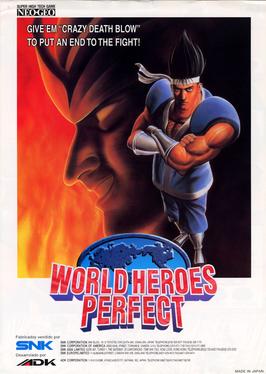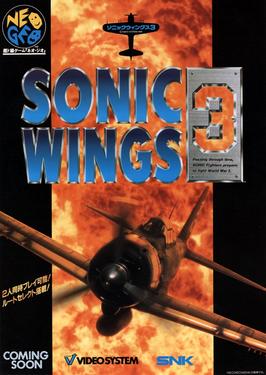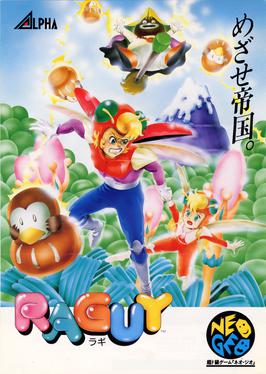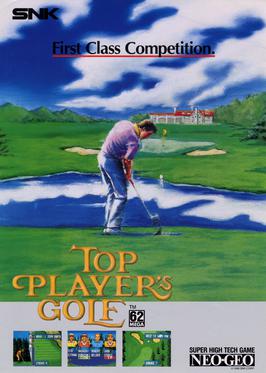
The Neo Geo, stylized as NEO•GEO and also written as NEOGEO, is a ROM cartridge-based video gaming system released on April 26, 1990, by Japanese game company SNK Corporation. Designed as both an arcade system board and home video game console, the Neo Geo was marketed as the first 24-bit system; its CPU is actually a 16/32-bit 68000 with an 8-bit Z80 coprocessor, while its GPU chipset has a 24-bit graphics data bus. It was a very powerful system when released, more powerful than any video game console at the time, and many arcade systems such as rival Capcom's CPS, which did not surpass it until the CP System II in 1993. Neo Geo hardware production lasted seven years; it was succeeded by Hyper Neo Geo 64.

Blazing Star is a shoot 'em up video game developed by Yumekobo and published by SNK in 1998 for the Neo Geo arcade and home systems. It is a follow-up to Pulstar (1995) and features side-scrolling action similar to its predecessor and different ships with varying characteristics. It was made less challenging than its predecessor, and the graphic quality was improved upon.

World Heroes Perfect is a 1995 fighting arcade game developed and published by ADK with the assistance of SNK. It was originally released for the Neo Geo MVS arcade cabinet on May 25, 1995. It is the fourth and final title of the World Heroes series.

Aero Fighters 2 is a vertical-scrolling shoot 'em up arcade game released in 1994 by Video System. It is developed by SNK and released in Japan, North America and Europe. It is the second part of the Aero Fighters series followed by the third part Aero Fighters 3 and a spin-off Aero Fighters Assault. It was initially released as a cabinet token base game.

Aero Fighters 3, known as Sonic Wings 3 in Japan and Europe, is a vertical-scrolling shoot 'em up arcade game released in 1995 by Video System. The Neo Geo AES version was not released in North America, but the Neo Geo MVS and Neo Geo CD versions were released in North America. The game was later released for Nintendo Switch in 2018 by the eventual copyright holder for the game, Hamster Corporation.

Last Resort is a horizontally scrolling shooter by SNK released as an arcade video game in 1992. It was also released for the Neo-Geo and Neo Geo CD systems, SNK Arcade Classics Vol. 1 for the PlayStation 2, PlayStation Portable, and Wii, as well as ACA Neo-Geo for the PlayStation 4 and Xbox One.

Burning Fight is a beat 'em up arcade game released by SNK in 1991 for the Neo Geo MVS system. Introduced to capture a share in the then-popular beat 'em ups market, it was meant to compete with Technōs' Double Dragon, the leader of the genre at the time. Three years after its release in the arcades and on the Neo Geo AES, it was released on Neo Geo CD as the only other home version.

Blue's Journey is a side-scrolling platform game released by Alpha Denshi in 1990 on SNK's Neo Geo MVS arcade system and their AES home system. It was ported to the Neo Geo CD in 1994. It was rereleased on the Wii's Virtual Console in Europe on November 9, 2007, followed by North America on November 12, 2007.

Ghost Pilots is a vertically scrolling shooter arcade video game released in 1991 by SNK. It has elements similar to Capcom's 194X series, but the player controls a seaplane.

League Bowling is an arcade game released in 1990 by SNK for the Neo Geo console and arcade systems. The players controls characters with red and blue hair and can select balls from 8 to 15 pounds. It is the only bowling game released on the Neo Geo.

Zed Blade is a horizontally scrolling shooter arcade video game developed by NMK and originally published by SNK on September 13, 1994. It is the only game created by NMK for the Neo Geo arcade platform. In a science fiction setting, players choose one of three characters to attempt to overthrow an army of enemies led by the on-board supercomputer at the automated Yggdrasil space station and seize full control of it once again.

Top Player's Golf is a golf arcade video game developed and originally published by SNK on May 23, 1990. It was one of the launch titles for both the Neo Geo MVS (arcade) and Neo Geo AES (home) platforms in the United States, the second golf game created by SNK after 1988's Lee Trevino's Fighting Golf, as well as one of the two golf games released for the Neo Geo, with the other one being Nazca Corporation's 1996 Neo Turf Masters.

Andro Dunos is a scrolling shooter arcade video game developed by Visco Corporation and originally published by SNK on June 15, 1992. It is the first title to be created by Visco for both the Neo Geo MVS (arcade) and Neo Geo AES (home) platforms. Andro Dunos, along with 1996's Breakers are the only two Visco developed games to be officially licensed for distribution on the Neo Geo AES platform. All other Visco games were only released on the Neo Geo MVS arcade platform.

Gururin is a puzzle arcade video game developed by Face, with the assistance of Minato Giken, and originally published by SNK on May 25, 1994. It was the first game to be created by Face for the Neo Geo platform and it was not released on the Neo Geo AES (home).

Over Top is a racing arcade video game developed by ADK and originally published by SNK on April 26, 1996. It is the spiritual successor to Thrash Rally, which was released earlier in 1991 on Neo Geo platforms.

Super Sidekicks is a 1992 soccer arcade video game developed and published by SNK. It is the first installment in the eponymous series and the second soccer game released for Neo Geo MVS, succeeding Soccer Brawl (1991). Featuring an arcade-style approach to soccer compared to other games released at the time, the title allows players to choose any of the available game modes with AI-controlled opponents or other human players with the team of their choosing. Its gameplay uses a simplified two-button configuration.

Super Sidekicks 2: The World Championship is a 1994 soccer arcade video game developed and published by SNK. It is the second installment in the Super Sidekicks series and the third soccer game released for Neo Geo MVS, preceding the original Super Sidekicks (1992). Featuring an arcade-style approach to soccer as its predecessor, the game allows players to choose any of the available game modes with AI-controlled opponents or other human players with the team of their choosing. Its gameplay uses a simplified three-button configuration.

Super Sidekicks 3: The Next Glory is a 1995 soccer arcade video game developed and published by SNK. It is the third installment in the Super Sidekicks series, succeeding Super Sidekicks 2: The World Championship (1994). Featuring an arcade-style approach to soccer like its predecessors, the game allows players to choose any of the available game modes to compete with AI-controlled rivals or other human players with their preferred team. Though first launched for the MVS hardware, the title was ported for Neo Geo AES and Neo Geo CD, in addition of being re-released through compilations and download services for various consoles. It proved popular among players and garnered positive reception from critics, however most reviewers noted that it felt more an update than a true successor to Super Sidekicks 2. It was followed by The Ultimate 11: SNK Football Championship in 1996.

Magical Drop III is a 1997 puzzle video game developed and published by Data East for the Neo Geo arcade and home platforms. It was later ported to Sega Saturn, PlayStation, Neo Geo Pocket Color, Game Boy Color, Windows, and Zeebo. It is the third entry in the Magical Drop series. In the game, the player takes control of one of several characters, battling against computer-controlled opponents. Gameplay is similar to previous entries albeit with further additions; the objective is to clear the screen of constantly advancing colored 'drops' via a character placed at the bottom of the playfield, which can grab drops and make them disappear by putting drops as a column of three or more of the same color. The player can also participate in a board-style adventure mode, while two players can play against each other in a competitive versus mode.




















